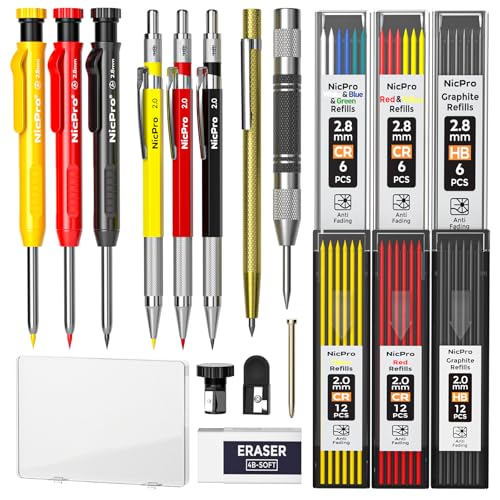When you’re on a construction site, precision and durability matter. You need tools that can withstand the rough environment and still deliver accurate results. That’s where a reliable mechanical pencil comes into play.
Unlike standard pencils, mechanical pencils offer consistent line thickness and don’t need constant sharpening. But with so many options out there, how do you choose the best one for your needs? Let’s dive into what makes a mechanical pencil perfect for construction work and highlight some top choices to keep your projects on point.
Understanding Mechanical Pencils for Construction
Mechanical pencils are essential on construction sites. They provide precise lines and withstand tough conditions.

Why Use Mechanical Pencils in Construction?
Mechanical pencils offer consistent line thickness, which is crucial for precision. They don’t need sharpening, saving time on site. These pencils usually come with hard leads, preventing breaks even on rough materials.
- Durability: Strong materials like metal or reinforced plastic ensure the pencil survives drops and heavy use.
- Grip: A comfortable, non-slip grip enhances control, even when hands are sweaty or wearing gloves.
- Lead Size: Opt for thicker leads, e.g., 0.9mm or above, to reduce breakage on rough surfaces.
- Eraser Quality: Integrated, high-quality erasers help correct mistakes quickly.
- Refill Mechanism: Easy-to-load refills keep you working without delays.
Top Mechanical Pencils for Construction Reviewed
Pencil 1: Model and Features
The Uni-ball Kuru Toga Roulette delivers consistency and durability. It features a rotating lead mechanism, ensuring even wear. The metal body withstands harsh conditions. The knurled grip offers control and comfort. It uses a 0.5mm lead, ideal for precise lines.
Pencil 2: Model and Features
Pentel GraphGear 1000 combines robustness and precision. Its dual-action retractor protects the lead and tip. The ergonomic metal grip provides comfort during long use. The pencil supports 0.5mm, 0.7mm, and 0.9mm leads. The built-in lead hardness indicator is useful.
Pencil 3: Model and Features
The Rotring 600 stands out for its reliability and design. The full metal body offers durability. It has a hexagonal barrel for a firm grip. The fixed lead guidance sleeve prevents breakage. The pencil typically uses 0.5mm or 0.7mm leads, suitable for various tasks.
Factors to Consider When Choosing a Mechanical Pencil
When picking a mechanical pencil for construction, several factors matter. Focus on durability, lead type, and grip comfort.
Durability and Build Quality
Look for solid construction materials. Metal or high-quality plastic offers resilience. Choose pencils with reinforced tips to avoid lead breakage. Consider brands known for rugged designs like the Rotring 600 or Pentel GraphGear 1000.
Lead Type and Thickness
Select the right lead thickness for your needs. Thicker leads, like 0.7mm or 0.9mm, work best for construction sketches. Choose lead grades like HB or B for a good balance between dark lines and durability. Leads with built-in rotating mechanisms, like the Uni-ball Kuru Toga, help maintain consistent line thickness.
Grip and Comfort
Comfort matters during long projects. Look for ergonomic grips. Rubberized or knurled metal grips provide better control and reduce hand fatigue. Consider pencils with customizable grip options for added comfort. Brands like Pentel and Rotring offer excellent grip features.
Using Your Mechanical Pencil Effectively on Site
A mechanical pencil ensures accuracy and durability on site. Know how to use it well and make the most of its features.
Maintenance Tips
Keep your mechanical pencil clean. Dust can clog mechanisms. Use a soft cloth to wipe it often. Replace old erasers to maintain neat corrections. Refill lead before it’s completely empty. A dry run can damage the pencil. Store it in a safe, dry place to avoid damage.
Techniques for Precision
Use a harder lead for fine lines. Soft leads are best for shading but can smudge easily. Choose 0.5mm lead for most tasks; it’s versatile and precise. Hold the pencil at a consistent angle. Varying angles can affect line thickness. Use a ruler or straight edge for exact measurements. Double-check your markings for accuracy.
Conclusion
« 10 Best Indoor Dog Gates of 2023 for Safety and Organization—Top Picks for Every Home
10 Stunning Wallpaper Trends of 2023 You Need to See for a Home Makeover »
Choosing the right mechanical pencil for your construction projects can make a world of difference in your work. With options like the Uni-ball Kuru Toga Roulette, Pentel GraphGear 1000, and Rotring 600, you’re set for precision and durability. Remember to consider factors like durability, lead type, and grip comfort when making your choice.
Don’t forget to maintain your pencil by keeping it clean and refilling lead and erasers regularly. Using harder lead for fine lines and maintaining a consistent angle can boost your accuracy. With the right mechanical pencil and a few handy tips, you’ll be ready to tackle any construction challenge with confidence. Happy building!









